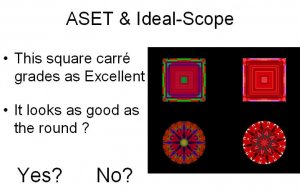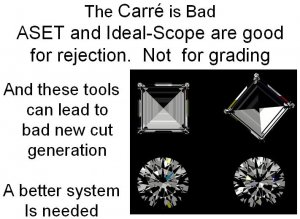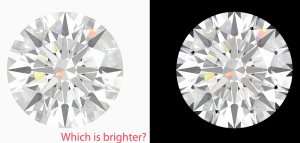Date: 5/4/2010 8:35:02 AM
Author: Paul-Antwerp
Date: 5/3/2010 1:08:30 PM
Author: ChunkyCushionLover
I hope this suggestion does not offend anyone, but the easiest way to break new ground is to build on top of currently published literature. One of my favourite works relevant to this discussion would be this article http://www.agslab.com/spie/spie_lo_res.pdf and its definitions and explanation therein.
I think it would be significantly easier to add, clarify, or modify the peer reviewed definitions found in this article than try to reinvent the wheel.
Gem Brilliance - Gemstone brilliance refers to the ability of a stone to appear illuminated to an observer. For this to occur light must be
directed from the virtual facets to the observer’s eyes. .... For understanding the illumination appearance of a gem it is useful to think of a gem’s facets and their optical projections,
the virtual facets, as a collection of tiny prisms that direct light to an observer’s eyes. Brilliance [can be defined] as the percentage by area of such tiny
prisms that can direct light to the observer’s eyes. This definition is simple and does not intend to account for obliquity factors that could be included to account for differences
in the relative position of facets or illumination conditions.
Gem Contrast - The high angular range ... indicates the zones in a stone crown that are not
illuminated due to the obscuration of the observer’s head. This obscuration produces what is known in the trade as
gem contrast. In proper amount and distribution, contrast creates structured lighting that enhances brilliance,
fire, and scintillation. Contrast can be a detrimental effect if t is significantly localized. Too little contrast results in a
stone appearance lacking variety under broad diffused illumination. Too much contrast results in a stone that lacks
brilliance. The combination of positive contrast characteristics and brilliance properties in a gemstone is known as contrast brilliance.
When a gemstone is in movement the contrast pattern changes in form. This effect is called dynamic contrast and adds substantial appeal to the appearance of a stone.
Gem Fire - The phenomenon of fire is one of the most appealing effects in transparent gemstones. Under favorable conditions
fire makes individual facets appear fully colored with the rainbow hues. Fire inherently occurs due to the light dispersion upon refraction as light enters and exits a stone.
Three factors determine the amount of fire perceived from a facet, namely, the angular dispersion of light upon refraction from the gemstone, the angular subtend of the source,
and the angular subtend of the eye’s pupil in relation to the facet. To best observe fire it is required to have a localized source of light so that its angular subtend is much smaller
than the angular dispersion produced by the gem facet, essentially a point source. As different colored rays arrive to the eye from a facet, some of them enter the eye’s pupil and others are blocked producing a colored appearance of the facet In this process the boundary of the eye’s pupil plays a critical role in obstructing portions of the spectrum to achieve the colored facet appearance.
Gem Scintillation - In the presence of brilliance and fire the most appealing effect is gem scintillation. Thus there are two major scintillation effects, fire and flash scintillation. To observe them it is required that the stone, the observer, or the illumination conditions be in movement. Typically the observer tilts the stone back and forth to observe scintillation and naturally optimizes for the direction that maximizes scintillation. Without brilliance ... there cannot be fire since no light can be brought to the observer’s eyes. Without fire there cannot be fire scintillation as defined by the change of fire pattern. Flash scintillation can occur without fire scintillation and it is due to ight sources not small enough in angular subtend to produce fire, or to the inability of a stone to sufficiently disperse ight for a given position of the observer. White diffused illumination will wash out both scintillation effects. Sources that subtend a small angle will contribute more to produce a flash effect, the rapid turn on and off of the light
from a given facet, than sources that subtend larger angles. Thus fire scintillation is more vivid than flash scintillation. The amount of gem scintillation perceived is linked to the brilliance and fire of a stone. However, scintillation strongly depends on the change of illumination conditions. This change is primarily produced on purpose by the movement of the stone as it is admired.
Thank you for looking up these definitions, CCL.
Reading and re-reading them, I think that AGS did a fine job here. May I suggest that they replace the definitions currently used in the PS-tutorial?
Live long,
re: "Brilliance [can be defined] as the percentage by area of such tiny prisms that can direct light to the observer’s eyes. "
If this percentage depends from Light source positions, I do not see real difference between AGS and Imagem Brilliance definitions .
If this percentage does not depends from Light source positions, I do not know what AGS Brilliance is.
Imagem :"Brilliance: A measure of a stone''s overall strength of light return that represents its average light return in the face-up position. This measure is determined by computing the mean gray-scale value of all pixels within the face up view of a diamond. Brilliance is average light return."






300x240.png)